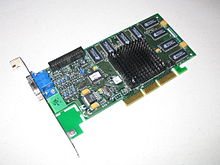- RIVA TNT2
-
Nvidia RIVA TNT2 Codename(s) NV5 Release date 1999 Entry-level GPU Vanta, M64 Mid-range GPU TNT2, Pro High-end GPU TNT2 Ultra Direct3D and shader version Direct3D 6.0 The RIVA TNT2 was a graphics processing unit manufactured by Nvidia starting in early 1999. The chip is codenamed "NV5" because it is the 5th graphics chip design by Nvidia, succeeding the RIVA TNT (NV4). RIVA is an acronym for Real-time Interactive Video and Animation accelerator.[1] The "TNT" suffix refers to the chip's ability to work on two texels at once (TwiN Texel).[2] Nvidia removed RIVA from the name later in the chip's lifetime.[2]
Contents
Overview
The TNT2 core is almost identical to its predecessor the RIVA TNT, however updates included AGP 4X support, up to 32MB of VRAM, and a process shrink from 0.35 μm to 0.25 μm. It was the process shrink that enabled improved clock speeds (from 90 MHz to 150+ MHz), which is where the substantial performance improvement came from.
The TNT2 offered a higher quality feature-set than some of its competitors, pioneered by the RIVA TNT, such as 32-bit color in 3D and support for larger 2048×2048 px textures. RIVA TNT2's competition included the 3dfx Voodoo2, 3dfx Voodoo3, the Matrox G400, and the ATI Rage 128.[3]
A low-cost version, known as the TNT2 M64, was produced with the memory interface reduced from 128-bit to 64-bit. Sometimes these were labeled "Vanta", continuing the Vanta name started with a value-oriented RIVA TNT-based product. This chipset outperformed the older RIVA TNT while being less costly to produce. They proved quite popular in the OEM market, as most consumers simply assumed all TNT2 cards were the same.
Product comparisons
The main competitor to the TNT2 was the 3dfx Voodoo3. What the Voodoo3 lacked when compared to the TNT2 was 32-bit color. This was the main selling point of the TNT2, while the main selling point of the Voodoo3 was the speed advantage it often had over the TNT2. The 3dfx Glide API was still popular at this time, and frequently performed better than alternative renderers (such as Direct3D and OpenGL). Some games also had exclusive 3D features when used with Glide, including Wing Commander: Prophecy.
The Voodoo3 and TNT2 also differ in that the Voodoo3 has a single dual-texturing pipeline (1x2), while the TNT2 has two single-texturing pipelines (2x1). This means that in games which only put a single texture on a polygon face at once, the TNT2 can be more efficient and faster. However, when TNT2 was launched, single-texturing was no longer used in most new games.
Variants
Falcon Northwest, a veteran gaming PC company, and Guillemot, an international video card manufacturer, at one point cooperated to create the Falcon Northwest Special Edition Maxi Gamer Xentor32. It was a TNT2 Ultra card designed to operate at a record-breaking 195 MHz core and similarly impressive 235 MHz RAM. This was far and away the highest clocked TNT2 model released. The card used special extremely low latency (for the time) 4.3 ns SDRAM to achieve the high RAM clock speed.[4] The regular Maxi Gamer Xentor32 came with the core clocked at 175 MHz and memory at either 183 MHz or 195 MHz, depending on which RAM chips the board arrived with.[5]
The Creative 3D Blaster TNT2 Ultra came clocked at the standard 150 MHz core and 183 MHz RAM. However, Creative included a unique software package that allowed the user to run software that used 3dfx's Glide. This wrapper, named Unified, was not as compatible with Glide games as real 3dfx hardware, but it was also the only card available other than a 3dfx card that could run Glide software.[5] This Glide wrapper was very slow, not without issues, and was rather unstable.[6] The main use of the wrapper was to allow 3D acceleration of games that only supported Glide 3D accelerators.
Hercules equipped their Dynamite TNT2 Ultra with faster-than-stock components, as well. The card came with a 175 MHz core clock and 200 MHz memory. The card lacked TV output, however.[5]
ELSA's Erazor III came clocked at non-Ultra TNT2 rates but included "3D Revelator" shutter glasses. These glasses made games look as though they were coming out of the screen, and worked with both Direct3D and some OpenGL titles.[5]
Chipset table
Competing chipsets
References
- ^ RIVA 128 Brochure, Nvidia, accessed October 9, 2007.
- ^ a b TNT2, Nvidia, accessed October 12, 2007.
- ^ Lal Shimpi, Anand. Nvidia Riva TNT2, Anandtech, April 27, 1999.
- ^ Freeman, Vince. Falcon Northwest Special Edition Xentor Review, Sharky Extreme, November 12, 1999.
- ^ a b c d "HSREVIEWS: TNT2 Round-Up" PC Gamer October 1999: 190.
- ^ TNT2 Glide - Creative Labs Unified, Guru of 3D, accessed July 5, 2007.
External links
- TNT2 - The Mainstream 128-bit TwiN Texel 3D Processor
- Drivers of Giga-Byte TNT2 M64 for Win98/2000/NT/XP
Nvidia Graphics processing units Early chipsetsRIVA seriesGeForce 256 · GeForce 2 · GeForce 3 · GeForce 4 · GeForce 5 · GeForce 6 · GeForce 7 · GeForce 8 · GeForce 9 · GeForce 100 · GeForce 200 · GeForce 300 · GeForce 400 · GeForce 500Other seriesTechnologiesMotherboard chipsets GeForce SeriesnForce SeriesnForce 220/415/420 · nForce2 · nForce3 · nForce4 · nForce 500 · nForce 600 · nForce 700 · nForce 900TechnologiesOther products Project DenverBridge chipsHandheldSoftwareAcquisitionsKey people Jen-Hsun Huang · Chris Malachowsky · Curtis Priem · David Kirk · Debora Shoquist · Dr. Ranga Jayaraman · Jonah M. AlbenCategories:- 1999 introductions
- Nvidia
- Video cards
Wikimedia Foundation. 2010.




